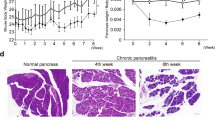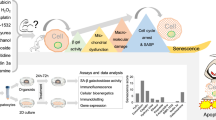Abstract
Liver regeneration after partial hepatectomy or liver injury is controlled by a wide variety of growth factors that are proven activators or inhibitors of hepatocyte proliferation. Liver regeneration post-hepatectomy has been proven to be decreased and delayed in cirrhotic vs. normal liver. Apoptosis seems to play an important role in cellular proliferation and in liver regeneration. Therefore, this study has analyzed the expression of apoptosis-associated genes following 2/3 hepatectomy in cirrhotic vs. normal rats. Cirrhosis was induced by a weekly intragastric administration of CCl4 for 16 weeks followed by hepatectomy and histological examination of the resected liver. Rats were sacrificed at 6 h, 12 h, 24 h, or 72 h after liver resection. The expression of proapoptotic (Bad, Bak, Bax) and antiapoptotic (Bcl-2, Bcl-XL) genes was analyzed by quantitative RT-PCR. We have observed an early increase in antiapoptotic mRNA levels and a delayed increase in proapoptotic mRNA levels in normal liver following hepatectomy. Before resection, proapoptotic mRNA levels were significantly higher in cirrhotic vs. normal liver. After hepatectomy, apoptotic mRNA levels were decreased and delayed as compared with that observed following hepatectomy in normal liver. These results indicate that apoptosis takes place in liver during CCl4-induced cirrhosis and could participate in the impaired regenerative response observed in cirrhotic liver.
Similar content being viewed by others
References
Franco D, Capussotti L, Smajda C, et al. Resection of hepatocellular carcinomas. Results in 72 european patients with cirrhosis. Gastroenterology 1990; 98: 733–738.
Chen MF, Hwang TL, Huang CF. Human liver regeneration after major hepatectomy. A study of liver volume by computed tomography. Ann Surg 1991; 213: 227–229.
MacIntosh E, Gauthier T, Pettigrew NM, Minuk GY. Hepatic fibrosis as a predictor of hepatic regenerative activity after partial hepatectomy in the rat. Hepatology 1993; 17: 307–309.
Chen MF, Hwang TL. The regeneration of cirrhotic liver after partial hepatectomy: A study using the rat carbon tetrachloride-induced cirrhotic model. Life Sci 1994; 18: 71–75.
Mitsue S, Hamanoue M, Tanabe G, et al. Expression of HGF and TGF-beta 1 mRNA, after partial hepatectomy in rats with liver cirrhosis. Surg Today 1995; 25: 237–243.
Kerr JFR, Kyllie AH, Currie AR. Apoptosis: A basic biological phenomenon with wide-ranging implications in tissue kinetics. Br J Cancer 1972; 26: 239–252.
Kren BT, Trembley JH, Krajewski S, Behrens TW, Reed JC, Steer CJ. Modulation of apoptosis-associated genes bcl-2, bcl-x, and bax during rat liver regeneration. Cell Growth Differenciation 1996; 7: 1633–1642.
Saini KS, Walker NI. Biochemical and molecular mechanisms regulating apoptosis. Mol Cell Biol 1998; 178: 9–25.
Kroemer G. The proto-oncogene Bcl-2 and its role in regulating apoptosis. Nature Medicine 1997; 3: 614–620.
Proctor E, Chatamra K. High yield micronodular cirrhosis in the rat. Gastroenterology 1982; 83: 1183–1190.
Higgins GM, Anderson RM. Experimental pathology of the liver. Restoration of the liver of the white rat following surgical removal. Arch Path 1931; 12: 186–202.
Knook DL, Blansjaar N, Sleyster EC. Isolation and characterization of Kupffer and endothelial cells from the rat liver. Exp Cell Res 1977; 109: 317–329.
Jean L, Lyoumi S, Salier JP. Quantitative reverse transcriptasepolymerase chain reaction of eukaryotic mRNA with the prokaryotic chloramphenicol acetyltransferase RNA as a universal, internal standard. Anal Biochem 1996; 234: 221–226.
Masson S, Scotté M, Franc¸ois A, et al. Changes in growth factor and cytokine mRNA levels after hepatectomy in rat with CCI(4)-induced cirrhosis.AmJ Physiol 1999; 277: G838–G846.
Napoli F, Bishop GA, MacCaughan GW. Increased intrahepatic messengerRNAexpression of interleukins 2, 6, and 8 in human cirrhosis. Gastroenterology 1994; 107: 789–798.
Napoli F, Prentice D, Niinami C, Bishop GA, Desmond P, McCaugham GW. Sequential increases in the intrahepatic expression of epidermal growth factor, basic fibroblast growth factor, and transforming growth factor beta in a bile duct ligated rat model of cirrhosis. Hepatology 1997; 26: 624–633.
Tzung SP, Fausto N, Hockenburry DM. Expression of Bcl-2 family during liver regeneration and identification of Bcl-x as a delayed early response gene. Am J Pathol 1997; 150: 1985–1995.
Fan G, Kren BT, Steer CJ. Regulation of apoptosis-associated genes in the regenerating liver. Semin Liv Dis 1998; 18: 123–140.
Sakamoto T, Liu Z, Murase N. et al. Mitosis and a apoptosis in the liver of interleukin-6–deficient mice after partial hepatectomy. Hepatology 1999; 29: 403–411.
Author information
Authors and Affiliations
Rights and permissions
About this article
Cite this article
Masson, S., Scotté, M., Garnier, S. et al. Differential expression of apoptosis-associated genes post-hepatectomy in cirrhotic vs. normal rats. Apoptosis 5, 173–179 (2000). https://doi.org/10.1023/A:1009645015601
Issue Date:
DOI: https://doi.org/10.1023/A:1009645015601




